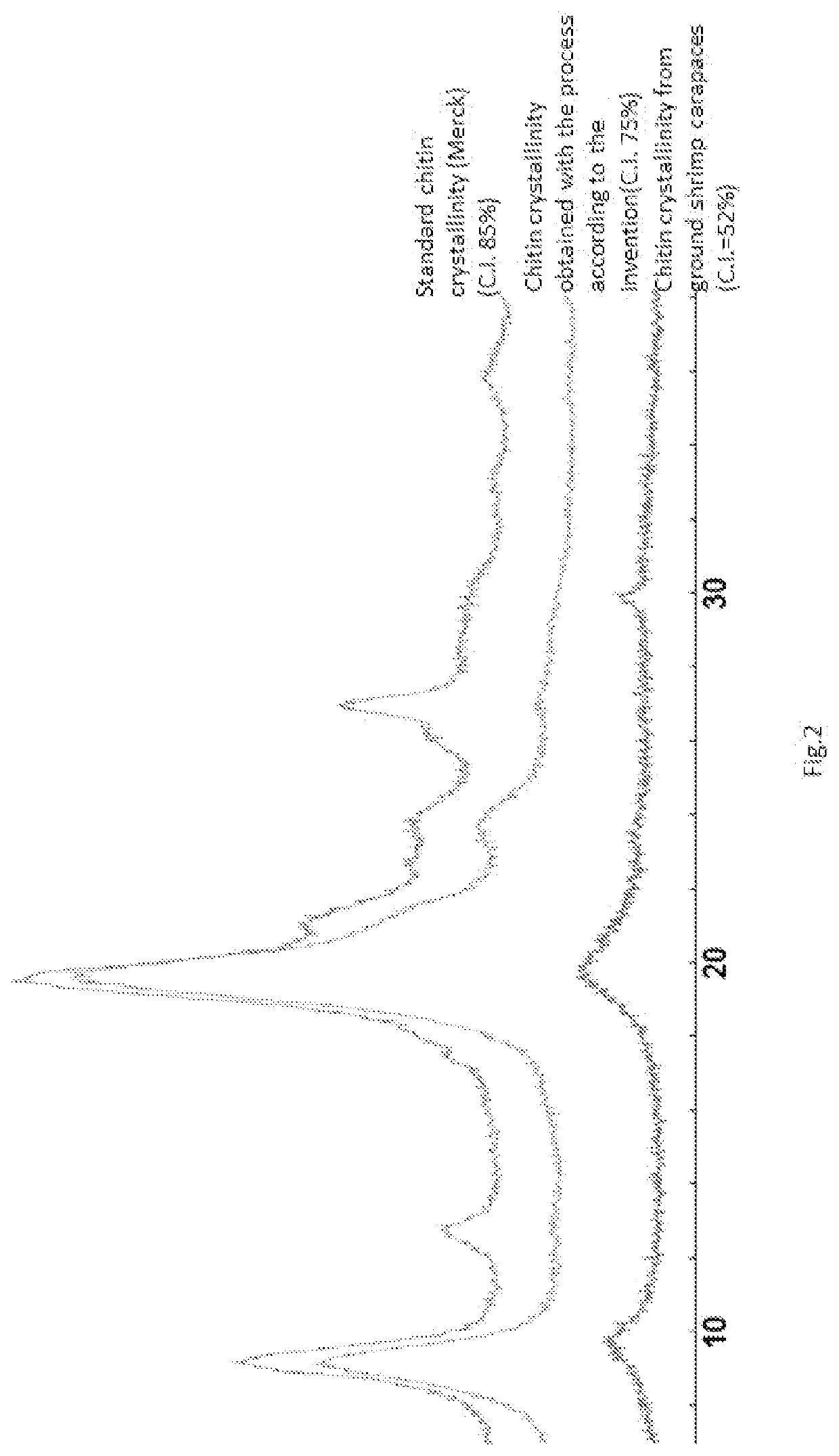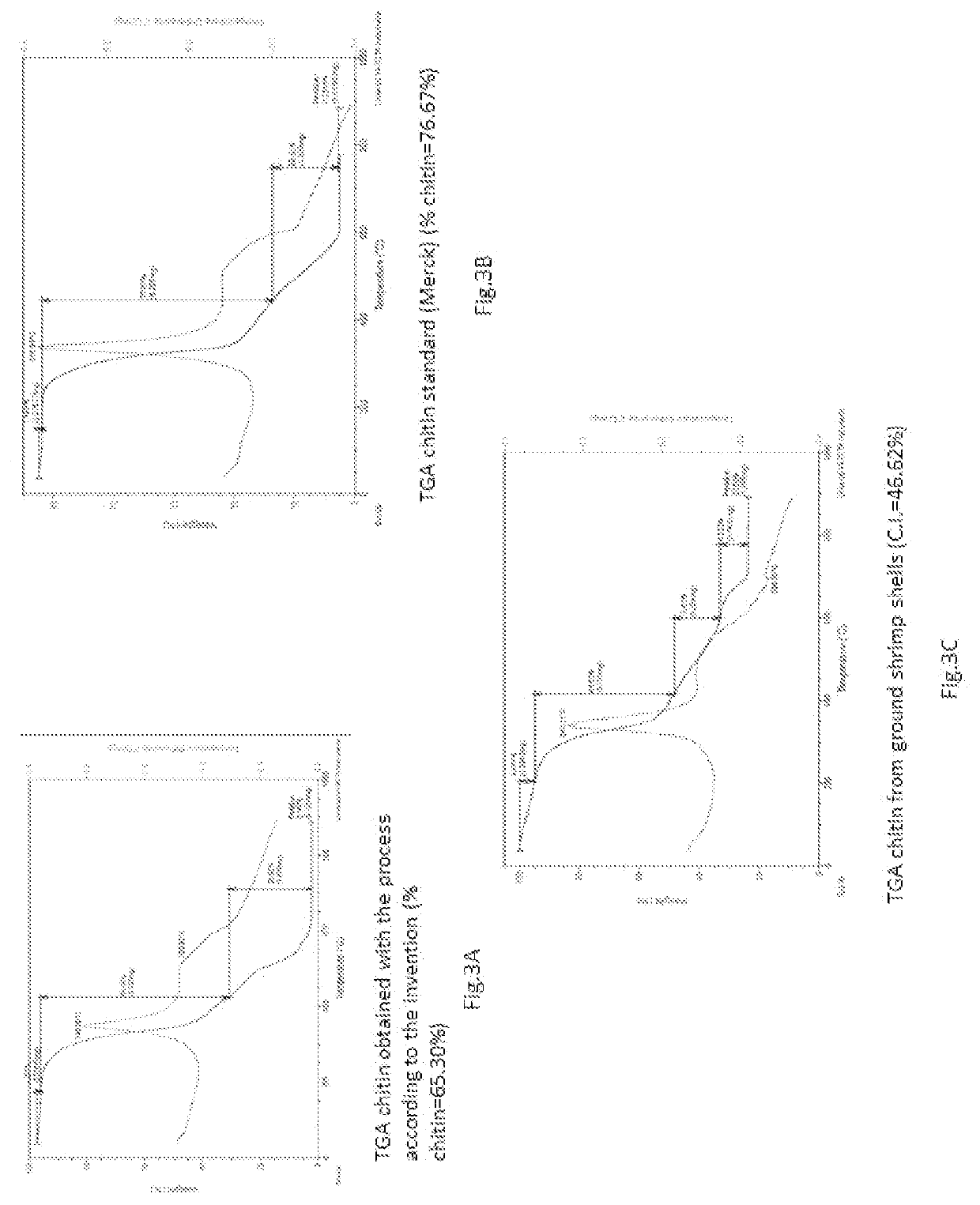Processes for extracting and purifying chitin by using green solvents
- Summary
- Abstract
- Description
- Claims
- Application Information
AI Technical Summary
Benefits of technology
Problems solved by technology
Method used
Image
Examples
example 1
[0069]In this example, 150 mg of shrimp carapaces and 1.5 g of DES choline acetate combined with glycolic acid, in a 1:1 molar ratio, were used with the addition of 30% ethanol by weight (450 μl).
Step A:
[0070]preparation of 150 mg dried and ground shrimp carapaces
[0071]mixing DES and ethanol with the shells for 2 h at 25° C.
[0072]centrifugation of the mixture and obtaining a chitin precipitate and a mixture of DES, ethanol, calcium carbonate, protein, astaxanthin.
Step B:
[0073]separation of the precipitated chitin
Step C:
[0074]washing the chitin precipitate six times with water at 20° C. The mixture containing water and DES is used in step D of the process;
[0075]centrifugation of the aqueous mixture;
[0076]separation of the chitin from the aqueous mixture, obtaining a chitin with a degree of crystallinity measured with X-ray diffractometry of 72% while the starting biomass which has a crystallinity of 52% and with respect to a commercial standard chitin obtained from shrimp carapaces, ...
example 2
[0079]In this example, 150 mg of shrimp carapaces and 1.5 g of DES choline acetate combined with levulinic acid, in a 1:1 molar ratio, were used with the addition of 30% ethanol by weight (450 μl).
Step A:
[0080]preparation of 150 mg dried and ground shrimp shells
[0081]mixing DES and ethanol with the shells for 2 h at 25° C.
[0082]centrifugation of the mixture and obtaining a chitin precipitate and a mixture of DES, ethanol, calcium carbonate, protein, astaxanthin.
Step B:
[0083]separation of the precipitated chitin
Step C:
[0084]washing the chitin precipitate six times with water at 20° C. The mixture containing water and DES is used in step D of the process;
[0085]centrifugation of the aqueous mixture;
[0086]separation of the chitin from the aqueous mixture, obtaining a chitin with a degree of crystallinity measured with X-ray diffractometry of 76% with respect to the starting biomass which has a crystallinity of 52% and with respect to a commercial standard chitin obtained from shrimp car...
example 3
[0089]In this example, 150 mg of shrimp carapaces and 1.5 g of choline glycolate were used, with the addition of 30% ethanol by weight (450 μl)
Step A:
[0090]preparation of 150 mg dried and ground shrimp shells
[0091]mixing ionic liquid and ethanol with the shells for 2 h at 25° C.
[0092]centrifugation of the mixture and obtaining a chitin precipitate and a mixture of ionic liquid, ethanol, calcium carbonate, protein, astaxanthin.
Step B:
[0093]separation of the precipitated chitin
Step C:
[0094]washing the chitin precipitate six times with water at 20° C. The mixture containing water and ionic liquid is used in step D of the process;
[0095]centrifugation of the aqueous mixture;
[0096]separation of the chitin from the aqueous mixture obtaining a chitin with a degree of crystallinity measured with X-ray diffractometry 75% higher with respect to that of the starting biomass (52%) and lower than that of commercial chitin (85%), in accordance with the measurements carried out with the TGA techniq...
PUM
 Login to View More
Login to View More Abstract
Description
Claims
Application Information
 Login to View More
Login to View More - R&D
- Intellectual Property
- Life Sciences
- Materials
- Tech Scout
- Unparalleled Data Quality
- Higher Quality Content
- 60% Fewer Hallucinations
Browse by: Latest US Patents, China's latest patents, Technical Efficacy Thesaurus, Application Domain, Technology Topic, Popular Technical Reports.
© 2025 PatSnap. All rights reserved.Legal|Privacy policy|Modern Slavery Act Transparency Statement|Sitemap|About US| Contact US: help@patsnap.com



